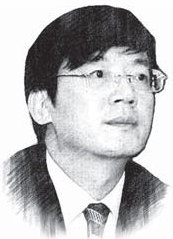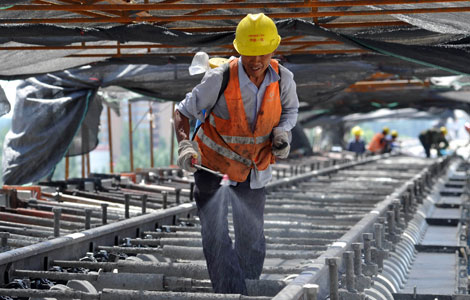Economic Watch: Half-Year Growth
Updated: 2013-07-17 07:06
(China Daily)
|
||||||||
Editor's note: Following the National Bureau of Statistics report on Monday about China's economic performance in the first half of the year, Premier Li Keqiang held a meeting to exchange views with some of the nation's leading economists and business leaders. Several other forums were also held to review the state of the economy.
Many issues were touched upon. For instance, in comparison with the near double-digit growth rate of China's GDP two years ago, is the economy growing too slowly? And in contrast with the short-term need to prevent growth from falling too low, are there some more dangerous long-term problems to tackle?
The following are the opinions from some thought leaders that China Daily collected from those forums.
Aggressive stimulus to blame for slowdown

He Keng former director of the National Bureau of Statistics
To continually step up fiscal expenditure and largely boost investment to maintain growth will no longer be a wise prescription as China's economy is facing headwinds, said a government policy adviser on Tuesday at a forum hosted by the China Center of International Economic Exchanges, a government think tank.
The over-dependence on investment during the last few years led to excessive production capacity and cumulative financial risks, threatening economic growth for a relatively long period, said He Keng, former director of the National Bureau of Statistics.
He described China's second-quarter GDP growth as "stable", and said that the country will not likely see a "hard landing", but that the downside risks cannot be removed in the short run.
On Monday, the NBS said that China's GDP grew 7.5 percent in the April-to-June period.
"The key problem of the decelerated growth is that both domestic and outside demand is lackluster, which is weakening economic development," He said.
He blamed the deepening imbalance of the world's second-largest economy on the aggressive stimulus program of 4 trillion yuan ($645 billion) started in 2008, which he called a "Keynesian-style policy".
"To some extent, (the stimulus package) has destroyed the structure of the national income's primary distribution and depressed the final consumption rate. As wages shrink, domestic demand is getting weaker."
The final consumption rate is the consumption-to-GDP ratio, an important indicator to gauge the health of the country's economic structure.
In the first half, consumption contributed 45.2 percent to the country's GDP, or 3.4 percentage points of the 7.6 percent year-on-year GDP growth. Investment, the biggest driver, contributed 53.9 percent to GDP growth, or 4.1 percentage points, according to the NBS.
Compared with the global average level, which is a 65 percent final consumption rate, China's economy is already dependent on strong investment to maintain growth, He said.
"Unfortunately, the consequences of the aggressive stimulus package are impossible to be eliminated in the near term."
Investment in fixed assets, especially in infrastructure construction, should be based on real demand and current fiscal capacity, the adviser said.
"Any increase in credit should make sure that borrowers are able to pay it back. Otherwise, the local debt problem and the shadow-banking system may spark a financial crisis," He warned.
The government should also reduce administrative controls on companies, and it should try to reduce costs for businesses, such as cutting taxes and lowering financing cost, said He.
Slower income growth flashes warning sign

Liu Yuanchun assistant dean of the School of Economics at the Renmin University of China
Slower growth in urban incomes may signal a deeper downside risk to China's economy, adding pressure to the consumption increase in the coming months, a senior economist warned on Tuesday at a forum hosted by the China Center for International Economic Exchanges.
In the first half, urban residents' average incomes stood at 14,913 yuan ($2,405), and the real increase rate was 6.5 percent year-on-year, down from 6.7 percent in the first quarter.
In the first half of 2012, urban incomes grew a real 9.7 percent, faster than the GDP growth rate of 7.9 percent.
The two quarters of consecutive drops in the income growth rate may indicate that the economic slowdown has passed to a deeper level, first from production to the financial sector and then to incomes, said Liu Yuanchun, assistant dean of the School of Economics at Renmin University of China.
"If the deterioration continues, it will restrain consumption, which will be a serious problem that we should pay attention to," Liu said.
The financial system sounded a warning in June through the liquidity squeeze in the inter-bank market, which suggested that the situation of the industrial sector depending on credit is unsustainable, he said.
"Shrinking incomes may become the next warning of an accelerating slowdown, which can influence the whole economy in a new cycle."
Growth downside risks in the world's second-largest economy are accumulating, along with the weak global environment.
Global economic growth began a new round of decline in late 2012, according to Liu.
The World Bank downgraded its forecast for global economic growth to 2.2 percent from 2.4 percent in June. Global GDP increased by 2.3 percent in 2012.
Liu said that weak overseas demand has depressed manufacturing output and further curbed investment in the industrial sector.
Excess capacity in resources, minerals and other manufacturing industries is broad in emerging economies, which may push the world economy into a new recession.
"Compared with the financial adjustment, reducing excess industrial capacity problem may need more time," Liu said.
In addition, the European economic recovery was weaker than expected, Liu said, which may continue to exert pressure on China's exports in the third quarter.
He expressed concern that the downside momentum in China may be intensified in the coming months, given negative signals in terms of the economic cycle and structural imbalances.
"It may get close to the growth bottom line that the government can tolerate in the third quarter, which may force the leadership to slightly adjust the current policy."
Nation's economy possibly faces more decline

Cai Hongbin dean of the Guanghua School of Management at Peking University
Given the economic slowdown in the second quarter of this year, Cai Hongbin, dean of the Guanghua School of Management at Peking University, says he is not optimistic about a pickup in the Chinese economy and warns about a possible further decline.
His opinion is based on the current overall economic slowdown as well as increased risk in substantial sectors of the economy.
Lack of confidence in the market and a rising jobless rate among graduates will last for a long time and contribute to a severe downward trend in the economy, he says.
Cai believes less demand for investment is the main reason for the slowdown, especially in the manufacturing sector. Because of the government's determination to restructure the industry, it has arrived at a turning point. It will take a long time for it to achieve real technological innovation, upgrade production equipment and reassign the factory market.
Also, risk has been further increased by the use of short-term financing for long-term projects regarding basic urban infrastructure. Although currently there is much room for more basic infrastructure, it would be better to arrange the capital to comply more closely with the significance of different projects, he argues. Private capital could also be introduced into the sector.
Furthermore, the government's reliance on domestic consumption to drive the economy in the process of transformation is still questionable. Although its contribution to China's gross domestic product has repeatedly exceeded 55 percent in recent months, the emphasis on boosting the proportion of consumption within the total economy is not sustainable as a long-term strategy, Cai argues.
Consumption relies heavily on salary increases, which are based on efficiencies in production. Increasing investment and improving technology are the most important factors in solving efficiency problems. Investment should play a bigger role in pushing the economy, the academic believes.
Foreign trade has merely edged up this year, unlike in past years when it positively surged ahead.
Cai maintains there is no need to exaggerate existing financial problems, such as real estate loans and shadow banking.
Nevertheless, China is experiencing a reasonable level of debt, the capital quality of commercial banks is in a good condition and there are enough foreign exchange reserves.
However, more attention should be paid to adjusting the nation's financial structure and dealing with potential risks in some sectors. Increasing financial risk will be a bad move.
In general, Cai suggests the government should speed up building a better and more loose commercial environment and encourage private investment to boost substantial enterprises.
Realizing the long-term nature of reform and working to stabilize the market are very critical to improving people's confidence in the market, he adds.
Fiscal gap widens at local government level

Ma Haitao dean of the School of Public Finance at the Central University of Finance and Economics
The gap between local governments' fiscal expenditures and revenues continues to widen. Slower economic growth is weighing on fiscal revenue, but local governments' fiscal expenditure has increased rapidly.
From January to May, fiscal spending increased 13.2 percent year-on-year, well above the 10 percent growth target.
At the current pace, local governments' aggregate deficit this year will total 1.7 trillion yuan ($277 billion), much more than the 1.2 trillion yuan deficit target set in the annual budget.
For the full year, I believe it will be difficult to realize the 8 percent growth target for fiscal revenue.
Fiscal spending will increase more than 10 percent. So, the fiscal deficit will be wider than expected.
The situation demands an overhaul of China's tax and fiscal system.
The near-term reform should focus on reform of fiscal expenditures, and the medium-term reform should emphasize changes in the fiscal system.
In the near term, the government should first refrain from doing things that should be done by the market.
Second, it should reduce tax breaks in some regions, including the western regions, special economic zones and border areas. In particular, I urge the State Council to stop approving tax-break proposals from local governments.
Third, clean up special financial transfer payments, which include too many items and are ill-managed. For example, the direct subsidy for grain is not linked with grain production or productivity.
Fourth, scale back government spending on cars, travel and dining. Establish a more transparent system of budget implementation.
In the medium term, it is essential to address the disparity between local governments' revenue and spending responsibility.
At present, local governments take half of the nation's fiscal revenue but are responsible for 80 percent of the spending. The central government should shoulder more responsibility for social security, some aspects of healthcare and education.
The central government should also shoulder funds that involve cross-regional management.
Local governments' revenue base should be strengthened by changing their major source, which is now land sales, to income tax, property tax and resource tax.
The financial transfer payments system should be reformed. If additional spending responsibility is assumed by the central government, the scale of transfer payments from the central to local governments should be reduced accordingly.
It is also important to streamline special transfer payment items and improve the structure. Many small items that do not have a significant demonstration effect should be scrapped.
GDP target in sight, but barely

Zhu Jianfang chief economist with CITIC Securities Co Ltd
Amid a continued slowdown, the nation's full-year 7.5-percent growth target can be achieved, but it will take an effort.
In view of the current situation, growth in the second half of this year is likely to continue slowing. Without a moderate adjustment in policies, and fully relying on the present economic momentum, there will be some difficulty in achieving the growth target.
Real external demand will slightly improve in the second half, but to a limited degree. Export growth in the second half will be a little faster than in the second quarter.
It is possible for exports to slightly pick up in the second half, reflecting moderate expansion in overseas demand and base effects compared with the second half of last year.
Fixed-asset investment growth will be under downward pressure in the second half of 2013 as infrastructure investment recedes and real estate investment rises and then declines.
Investment in manufacturing will continue its adjustment period for another year or two. For the full year, we will see fixed-asset investment grow about 20 percent.
Consumption growth in the second half will remain weak and the whole year will see total retail sales rise 12.8 percent year-on-year. Sales of housing-related products and vehicles will see quite good growth in the second half.
The consumer price index, which gauges consumer inflation, will rise 2.5 percent year-on-year in 2013 while the producer price index, which measures wholesale inflation, will fall 1.7 percent.
I think the major problems in China's current economic situation are as follows.
First, the financial sector is remarkably far from supporting real economic growth. A sluggish economy requires more money to achieve similar growth, while China's interest rates, which are yet to be marketized, offer wide scope for risk-free arbitrage.
Large companies get preferential loans and re-lend the money or put it into financial products, which has expanded the total social financing scale.
Some credit in recent years flowed into industries with excess capacity or public services facing funding shortages, leaving rollovers as a solution to extend the debts.
Second among China's problems is that industrial overcapacity is spreading into an increasing number of industries.
Third, housing prices keep rising.
Fourth, fiscal pressure keeps mounting. The growth of fiscal revenue has eased and may miss the full-year target.
A new stimulus package should be avoided and the slowest acceptable growth pace should be maintained, serving to produce economic restructuring and growth in the medium and long term.
As macroeconomic policies are kept stable, market-oriented reforms and the decentralization of government power should be further advanced to create the internal dynamic for economic growth.
First comes stabilizing investment growth and ensuring continued funding for projects in progress. While avoiding further stimulus, we should try to ensure capital for projects that have begun and avoid "investment stall" as 20-percent or higher full-year investment growth will essentially support the 7.5-percent GDP growth target.
Second, monetary policy should remain steady while liquidity should return to neutral. The yuan's pace of appreciation should not be too fast. Liquidity and money supply growth should return to a neutral stance with the broad money supply (M2) expanding 14 to 15 percent.
Third, speed up interest-rate marketization and reduce financing costs while strengthening liquidity monitoring and crisis management.
Fourth, welcome advancing market-oriented adjustment of the real estate sector, including increasing supply in first-tier or large cities and scrapping the supply-tightening policies for restoring house prices by market means.
Fifth, advance reforms to effectively resolve overcapacity. Reasonable industrial planning is necessary for dispelling overcapacity. More opportunities should be created for manufacturing transformation, especially through opening up the monopolized and regulated fields.
(China Daily 07/17/2013 page15)

 Panama finds 'missile equipment' aboard DPRK ship
Panama finds 'missile equipment' aboard DPRK ship
 Free on his feet
Free on his feet
 Extreme heat causing vehicle fires
Extreme heat causing vehicle fires
 Men, you look good in slim elegant cut
Men, you look good in slim elegant cut
 Luxury dresses in plastic
Luxury dresses in plastic
 Obama urges restraint amid protests
Obama urges restraint amid protests
 Putin wants Snowden to go, but asylum not ruled out
Putin wants Snowden to go, but asylum not ruled out
 Apple to probe death of Chinese using charging iPhone
Apple to probe death of Chinese using charging iPhone
Most Viewed
Editor's Picks

|

|

|

|

|

|
Today's Top News
Asiana crash passengers sue Boeing
Li highlights economic restructuring
Merkel's rivals go on attack over US spying
'Missile equipment' found aboard DPRK ship
Egypt's interim govt takes oath
Gay marriage to be legal in UK
China signs cooperation agreements with Belarus
Philippines' accusation refuted
US Weekly

|

|





